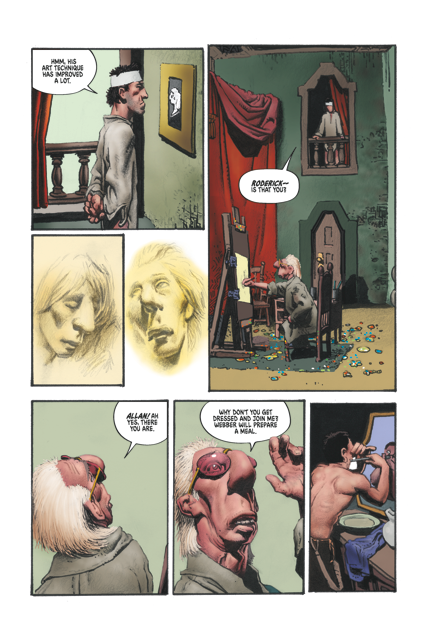“Corben captures the energy and the imagination of Poe, while doing something that could only work in comics, something that takes full advantage of the art form.”
Dark Horse Comics Editor in Chief, Scott Allie.
It would be difficult to put in numbers how many adaptations the works of Edgar Allan Poe have spawned; impossible for those he has influenced. More than 164 years after his death, Poe remains the most influential of all American authors, despite his modestly sized canon of fiction and poetry. Sometimes, odes to Poe are entertaining and witty – sometimes they veer so far from Poe’s original work they become ridiculous or even offensive. Every now and then someone will read Poe and forge an intricate bond with his words that will lead to great works of art being created – like Charles Baudelaire, Ray Bradbury, and now illustrator and comics icon, Richard Corben. These masters of their craft in turn inspire an entire generation of artists, who will eventually return to the original source: Poe.
Corben, who began as an underground comic book artist in the 70s and was inducted into the Eisner Award Hall of Fame last year, is no stranger to adapting Poe. There were the ones published for Creepy back in the 80s at a time Corben was more familiar with Poe through the movies of Roger Corman. He also adapted Poe for Marvel in Haunt of Horror, among others. After having become more familiar with Poe’s works, Corben found he was deeply drawn to particular characters and decided he wanted more control over his adaptations. It was this need to have the freedom to interpret Poe’s works how he wanted that led him to Dark Horse Comics. As both writer and illustrator and with total creative control, Corben has already adapted classics including “The Conqueror Worm”, “Berenice” and “The Sleeper.” Now, Corben takes on one of the most revered horror stories of all time: Poe’s “The Fall of The House of Usher” considered the best example of Poe’s theory of the unity of effect in practice. Dark Horse will publish Corben’s latest take on twisted twins Roderick and Madeline in two separate issues, with the first out on May 15.
“Doing these comics with Corben reminds me how fun Poe is. I’d sort of lost track of that, having not looked at the original work in a long time,” says Dark Horse Comics Editor in Chief, Scott Allie. “Corben captures the energy and the imagination of Poe, while doing something that could only work in comics, something that takes full advantage of the art form.”
The way Corben interprets Poe brings to mind how the French saw him – from Baudelaire to Paul Valéry – and to the literary theorists of post-structuralism that evolved in France after the mid 1960s that heralded a new mode of thinking about the reading of texts. It was one far removed from the axiom that every text had a final and defining truth; something Jacques Derrida declared a paradox because each person interpreted a text differently. It projected the spotlight onto the reader for the first time; free to interpret a text by their own reasoning. In his adaptation of “Usher”, Corben takes the liberty of showing us how ‘acute’ he believes Usher’s sickness to be and what he thinks Usher’s ‘oppressive secret’ is.
From the original introductory passage of Poe’s story, Corben chooses to overlook the words ‘dark’ and ‘dull’ opting instead to focus on the word ‘autumn.’ For someone who sometimes seems to show a preference for grey illustrations, Corben’s colors are scintillating in the opening pages – a spectacular display of sensational yellows and greens, as we see protagonist ‘Young Allan’ make his way to the House of Usher. On his first night alone in the forest we marvel at a violet sky, and wonder how the moon can be such a delectable shade of cool blue? The dawn of the next day allows Corben to ignite the pages with burnished orange as Allan proceeds towards the doomed abode. As he approaches, it is impossible to ignore the magical way Corben captures the atmosphere of the infamous ‘black and lurid tarn’ as well as the eeriness surrounding the intimidating structure. As to what Allan stumbles upon once inside, you will have to see for yourselves.

An exclusive look at Roderick Usher from The Fall of the House of Usher #1
In the depiction of Roderick Usher we see clearly the ‘inordinate expansion above the regions of the temple’ but Corben puts his own unique stamp on the enigmatic recluse – a cool pair of rose-tinted shades – to protect Roderick’s eyes, which Poe’s narrator told us ‘were tortured by even a faint light.’ ‘Miss’ Madeline in this comic shows little resemblance to Corben’s sinister brunette from his 1989 adaptation, nor do we find a likeness to the ghost-like figure Poe’s protagonist glimpsed. Instead, it is a voluptuous and vulnerable blonde that we meet, and she is trying desperately to get away from her brother: a plot in which she will enlist the help of Young Allan.
Corben’s atmospheric adaptation of “Usher” allows the secondary senses of the reader to infiltrate the narrative, enabling their own imagination and theoretical ideas to be interspersed with the text. Corben easily draws the reader deeply into his story, as it becomes more intriguing and more terrifying with each turn of the page. There is ghastliness, erotic undertones, fabulous attention to detail as well as the dark humor that makes reading Corben so enjoyable.
“Dark Horse’s horror line always has a bit of a traditional edge to it—we don’t tend to do the gratuitous kind of horror that a lot of horror film goes for,” says Scott Allie. “But we don’t want to do museum pieces, we want to remain current. Corben has taken what could be the ultimate museum piece, and because he doesn’t view it as cold and dated, he’s able to make something fresh and bizarre.”
Those familiar with Poe’s horror tales will notice another story sneaking into the narrative over the final pages of Issue One of “Usher” as it reaches its climactic end, leaving us to wonder where Corben will take the tale in Issue Two. Corben’s exciting new take on Poe’s “The Fall of the House of Usher” is a gothic masterpiece horror aficionados will relish – and a fine ode to one of the Master of Macabre’s most important works.
A preview of Edgar Allan Poe’s “The Fall of the House of Usher” by Richard Corben is available here.
















Comments are closed.